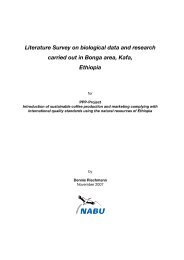Flora Biodiversity Assessment in Bonga, Boginda and Mankira Forest
Flora Biodiversity Assessment in Bonga, Boginda and Mankira Forest
Flora Biodiversity Assessment in Bonga, Boginda and Mankira Forest
Create successful ePaper yourself
Turn your PDF publications into a flip-book with our unique Google optimized e-Paper software.
The forests are also <strong>in</strong> the process of degradation due to a number of other factors such as<br />
coffee grow<strong>in</strong>g <strong>in</strong> the forest, livestock rear<strong>in</strong>g, <strong>and</strong> harvest<strong>in</strong>g of fuelwood <strong>and</strong><br />
construction material. Dur<strong>in</strong>g clear<strong>in</strong>g of the forest floor for coffee plantation everyth<strong>in</strong>g<br />
is cleared or slashed down. Hence seedl<strong>in</strong>gs <strong>and</strong> sometimes sapl<strong>in</strong>gs of important tree<br />
species are cleared together. In order to allow sun light some canopy trees are also cut<br />
down. Livestock are seen <strong>in</strong> almost all forest areas <strong>and</strong> unless they are controlled they can<br />
affect plant growth through trampl<strong>in</strong>g, brows<strong>in</strong>g, break<strong>in</strong>g young sapl<strong>in</strong>gs <strong>and</strong> trees.<br />
Although it is difficult to substantiate the cause of death of trees <strong>in</strong> this study, <strong>in</strong>sect <strong>and</strong><br />
pests <strong>in</strong>troduced via animal <strong>and</strong> human may attack <strong>and</strong> affect the vitality of the forest.<br />
Any scar created on a tree as result of animal or human contact may cause disease later<br />
on it could kill the tree. In this study the number of stumps <strong>and</strong> dead trees were estimated<br />
<strong>and</strong> the follow<strong>in</strong>g results are obta<strong>in</strong>ed: dead trees per hectare are 292 <strong>in</strong> <strong>Bonga</strong>, 433 <strong>in</strong><br />
Bog<strong>in</strong>da, <strong>and</strong> 359 <strong>in</strong> <strong>Mankira</strong>. The stumps were counted <strong>in</strong>order to evaluate level of<br />
exploitation <strong>and</strong> the results are 189 for <strong>Bonga</strong>, 27 for Bog<strong>in</strong>da <strong>and</strong> 82 for <strong>Mankira</strong>. As the<br />
figure shows <strong>Bonga</strong> forest is more affected by logg<strong>in</strong>g than the rest of the forests.<br />
Because of absence of scientific management such as silvicultural practices, all forests of<br />
the country, as well as those <strong>in</strong> the study area, are mostly affected by thick climbers that<br />
are silviculturally <strong>and</strong> economically undesirable species. As a result of this phenomena<br />
economically <strong>and</strong> silviculturally important tree species are crooked, bend <strong>and</strong> fluted.<br />
Regeneration status too might be <strong>in</strong>fluenced negatively. Trees that are dead are rott<strong>in</strong>g <strong>in</strong><br />
the forest. This might help <strong>in</strong> nutrient cycle but they might also harbor disease. Absence<br />
of management plan also leads to over exploitation where annual cut exceeds mean<br />
annual <strong>in</strong>crement.<br />
In conclusion exist<strong>in</strong>g threat to the forests is associated with anthropogenic activities.<br />
Schmitt C. B. 2006, referr<strong>in</strong>g Gil et al., 2004 has emphasized how important Ethiopian<br />
forests are <strong>in</strong> terms of gene pool <strong>and</strong> number of endemic species. However, the author<br />
witnessed that human <strong>in</strong>duced pressure threatened the exist<strong>in</strong>g forests of Kaffa zone. The<br />
forests are <strong>in</strong> fragile <strong>and</strong> fragmented state. This great biodiversity coupled with the<br />
42



